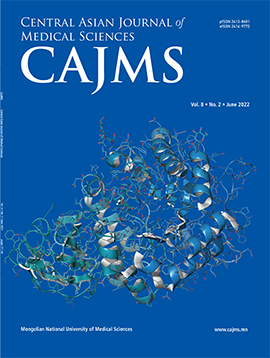The Hepatoprotective Activity of the Traditional Multicomponent Formulation Gurgem-13 on Carbon Tetrachloride (CCL4) Induced Experimental Liver Injury in Rats
DOI:
https://doi.org/10.24079/cajms.2019.12.005Keywords:
Multicomponent formulation, Liver injury, Gurgum-13, Hepatoprotective remedy, LilicoaguliantAbstract
Objectives: The purpose of present study was intended to evaluate hepatoprotective effects of traditional multicomponent formulation Gurgum13 on carbon tetrachloride (CCI4) induced liver injury model in rats. Methods: Chronic toxic liver injury was induced experimentally by intraperitoneal injection (IP) of 1.0 ml/kg body weight of 10% carbon tetrachloride (CCI4) three times per week for duration of three months in rats. A total of five groups of animals with 15 rats in each were used for the experiment. Group 1 was as a normal control (intact). Group 2 served as a control group received CCI4 1.0 ml/kg IP three times a week for 3 months. Group 3, 4 and 5 were as the treatment groups received CCI4 1 ml/kg IP and administered traditional multicomponent formulation Gurgum-13 as a test drug (100 mg/kg) for 3 months daily. Milk thistle (50 mg/kg) and Lilicoaguliant (LLC) (100 mg/kg) were given daily for 3 months as a reference drug respectively. The activity of Gurgum-13 formulation and other comparative drugs were investigated with the dynamic study of liver marker enzymes, AST, ALT, ALP, bilirubin, and the antioxidant and blood coagulating effects of the remedy, which were studied in three months of experimentation. Gurgum-13 is one of the Mongolian traditional multicomponent formulation used in practice for a range of diseases including liver disorders. Results: Carbon tetrachloride significantly decreased the liver functions as assessed through an increase in blood serum and liver marker enzymes in control groups. Gurgum-13 treatment significantly prevented hepatotoxicity of carbon tetrachloride by reducing ALT, AST, ALP marker enzymes and bilirubin in blood serum and liver tissue in the three months period of chronic hepatitis (p<.05) similar to reference drugs. The result of the study revealed that Gurgum-13 is significant hepatoprotective against liver injury from CCI4 induced hepatotoxicity by having antioxidant effect and decreasing lipid peroxidation in liver. Conclusion: Multicomponent traditional formulation Gurgum-13 demonstrated very good hepatoprotective effect against CCI4 induced liver injury in rats. Thus, Gurgum-13 can be an effective remedy for the treatment of chronic hepatitis and biliary tract disorders.
Downloads
217
Downloads
Published
How to Cite
Issue
Section
License
Copyright (c) 2019 Mongolian National University of Medical Sciences

This work is licensed under a Creative Commons Attribution-NonCommercial 4.0 International License.




